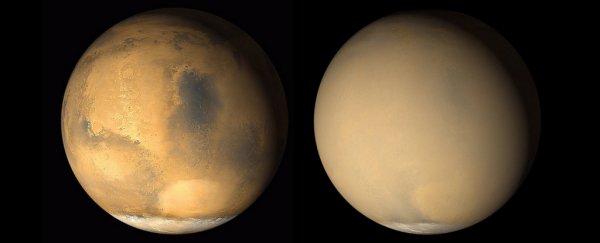Mars is not a friendly place to be right now, especially if you're an aging solar-powered rover.
NASA says a global dust storm is forming. The storm is now about 10 billion acres in size, which is enough to cover North America and Russia, or more than one-quarter of Mars. Some regions of the Martian surface have become so obscured that daylight has turned to darkness.
"The storm is one of the most intense ever observed on the Red Planet," NASA said in a press release.
Dust storms on Mars start with sunlight. As soil gets warmed up, updrafts form in the thin Martian air and create dust devils, which suck fine dust high into the atmosphere.
 (NASA/JPL-Caltech/MSSS)
(NASA/JPL-Caltech/MSSS)
Over time the dust clouds grow to encompass entire regions, and those regional storms can combine to form globe-engulfing weather events.
During a teleconference on Wednesday, NASA researchers said they expect the storm to wrap around the entire planet within two or three days.
What the Martian dust storm looks like from the ground
From the surface of the red planet, NASA says Mars looks something like this:
 (NASA/JPL-Caltech/TAMU)
(NASA/JPL-Caltech/TAMU)
The above image is a series of pictures that NASA simulated from the perspective of its Opportunity rover. The pictures show what the sun and sky look like during the brightest time of the day, and they're based on real photos taken by the rover.
The bright spot is, of course, the sun. It looks somewhat blue due to the composition of Mars' air (which is about 1% as thick as Earth's).
NASA didn't specify which point in the storm the far-left image shows, but the agency said the far-right picture depicts what the Martian sky looks like this month — the sun is entirely blotted out to Opportunity.
The solar-powered Opportunity rover landed on Mars in 2004 and was supposed to last 90 days, though it has operated for more than 14 years.
But light is now so dim near Opportunity that NASA put the rover to sleep to conserve power, since its solar panels can't collect enough energy to operate normally.
If enough dust covers the solar panels of the aging robot, Opportunity could be in danger, as scientists have said in the past. That's because it may not be able power its electronic circuits enough to prevent severe cold on Mars from damaging them.
Meanwhile, NASA's car-size Curiosity rover is doing fine, since it runs on nuclear power. It's also in a region that isn't as darkened as much by the storm.
 (NASA/JPL-Caltech/MSSS)
(NASA/JPL-Caltech/MSSS)
This article was originally published by Business Insider.
More from Business Insider: